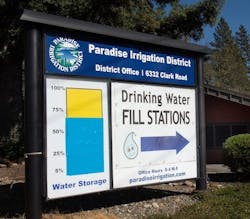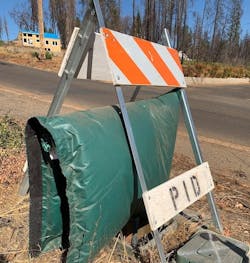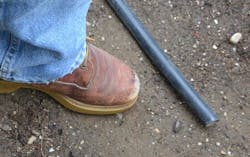About the author:
Steve Cooper is a writer for SCA Communications. Cooper can be reached at [email protected].
The rebuilding of the town of Paradise, California, which was destroyed by the Camp Fire, continues with a focus on the rapid replacement of water service lines.
“When we’re done, there will be about 315,000 feet of new HDPE service lines,” said Kevin Phillips, Paradise town manager.
Camp Fire Devastation
Prior to the 2018 fire, the town had a population of 26,000. During 17 days starting on November 8, 2018, the fire destroyed around 150,000 acres and nearly 19,000 homes and buildings were burned.
The Paradise Irrigation Department is replacing all water service lines using high-density polyethylene (HDPE) PE 4710 pipe in diameters of 1 to 2 inches. The pipe, PolyFlex CTS potable water service tubing from Advanced Drainage Systems Inc. (ADS), is resistant to rot and corrosion, can be easily installed and is consistent with industry specifications for potable water.
“This SDR 9 PolyFlex tubing from ADS is produced in accordance with AWWA Standard C901 and meets NSF 14 and 61 standards,” said Camille George Rubeiz, P.E., F. ASCE, co-chair, HDPE municipal advisory board member and senior director of engineering of the municipal and industrial division of the Plastics Pipe Institute Inc. (PPI). “This means that the pipe is certified for potable water systems because it meets or exceeds the requirements for health effects in drinking water components, and also the performance criteria of plastic piping components as stipulated by NSF.”
Rubeiz said this compound is especially good for trenchless and open cut installations, and noted the pipe is also resilient to surge events and fatigue.
“The ANSI/AWWA C906-15 standard includes PE 4710 for sizes up to 65 inches and recognizes the increased durability and reliability of HDPE pressure pipe used in water systems,” he added.
Burnt Pipes Create Benzene?
After the fire, accusations were made that sections of burnt plastic pipe found above ground created benzene, which found its way into the Paradise water system. PPI, the major North American trade association, investigated.
“These claims are patently false,” said David Fink, PPI president. “There has been no evidence that plastic pipes are responsible for the production of benzene or any other contaminant due to the heating of the pipes during the Camp Fire. It’s clear that the contamination was from the millions of tons of the fire-ravaged environment that got sucked into water system.”
Phillips, the Paradise town manager, echoed the statement of Fink and PPI.
“What the district saw was that the contamination from the fire was not associated with any particular pipe material, and that even the galvanized and copper pipes that were in the ground saw the same amount of contamination as the polyethylene.” he said. “There was a similar percentage of contaminated service laterals with those other materials as there was with polyethylene. So, we decided to continue to use polyethylene because of the ease of use and the cost being the best on the market. We felt it would be the best choice for the rebuilding of Paradise.”
Paradise was built over the course of many decades, he added. When it was first being built, many of the pipes, like many communities in the U.S., were lead. During a population boom in the 1950s, galvanized steel became the pipe material of choice, but due to corrosion issues, the community switched to copper pipe, which had become an industry standard at the time.
“Again, there were flexibility and corrosion issues especially with the acidic soil conditions,” Philips said of the copper pipe. “And so, the district finally moved to polyethylene because of the durability, and made that our standard. We felt it would be in the ground for many, many years. Even after the fires, we found the buried polyethylene was undamaged from direct contact with heat. The issue we found was contamination in the majority of service laterals which served burned structures, regardless of material type so, we needed to replace those service lines.”
The use of HDPE pipe also allowed the community flexibility in terms of pipe sizing, he said. The utility could up-size services lines to support the rebuilding effort after the fire, which would meet customer and fire requirements. The pipe is also resilient in the face of seismic activity, and with trenchless technology, new lines are quick to install.
“We felt the best form of protection for our service laterals was not the material itself, but just putting in backflow protection to reduce the chance of contamination entering the system during a depressurization event,” Phillips said. “Again, we believe the occurrence of contamination wasn’t associated with the material of the piping, it was associated with the depressurization, contamination being drawn into the system and how long the system was disconnected to allow that contamination to adsorb into the pipe walls.”
Phillips estimated that the new town of Paradise will take nearly 20 years to be rebuilt back to where it was prior to the Camp Fire.
“It takes a long time to build homes,” he said. “We have had a huge surge of building permits issued in the town of Paradise. There is a ton of pressure on getting new water service to those new rebuilds. And with polyethylene, it has created efficiencies so that we can get out there and get a service line in within an hour or two of that request.”
The speed of installation combined with the ability to work around on-site challenges —such as rocks, other services lines, and roads—accelerates the process of getting things rebuilt smoothly.
“It makes the rebuild process and getting the water service back a lot easier than it would be if we had to bore through with a steel or copper,” Phillips said. “PE is our standard moving forward and throughout the rebuild process.”
Additionally, large diameter N-12 corrugated HDPE pipe is being used on several storm water drainage projects in Paradise. These include the Paradise tennis courts and the Paradise softball field.
About the Author
Steve Cooper
Steve Cooper is a writer for SCA Communications. Cooper can be reached at [email protected].



